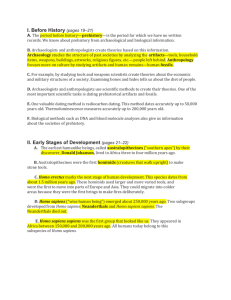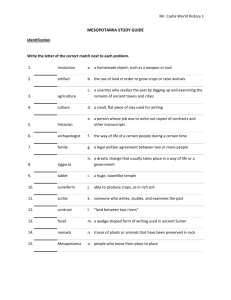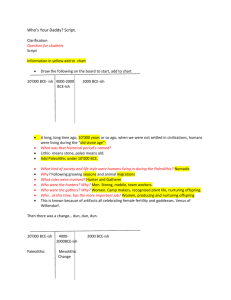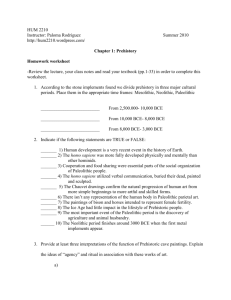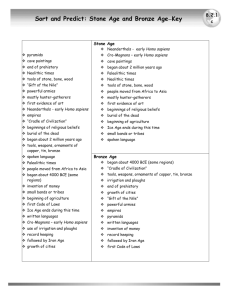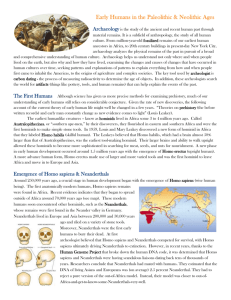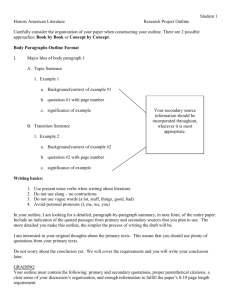The Paleolithic Age WHAP/Napp Do Now: Reading – Paleolithic
advertisement
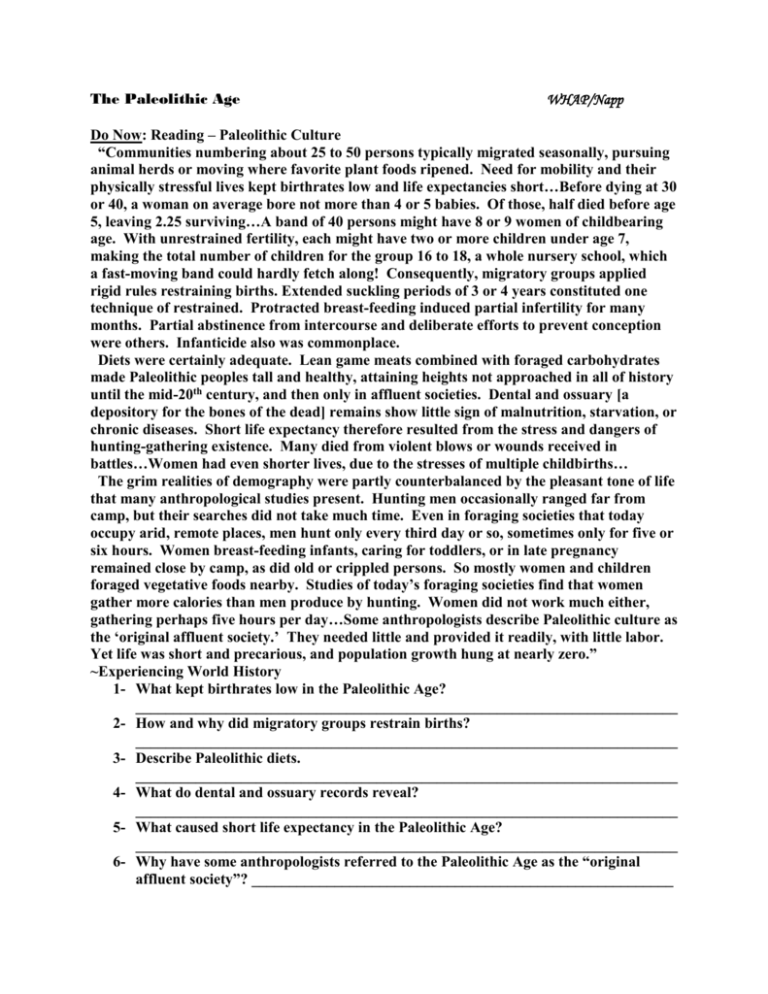
The Paleolithic Age WHAP/Napp Do Now: Reading – Paleolithic Culture “Communities numbering about 25 to 50 persons typically migrated seasonally, pursuing animal herds or moving where favorite plant foods ripened. Need for mobility and their physically stressful lives kept birthrates low and life expectancies short…Before dying at 30 or 40, a woman on average bore not more than 4 or 5 babies. Of those, half died before age 5, leaving 2.25 surviving…A band of 40 persons might have 8 or 9 women of childbearing age. With unrestrained fertility, each might have two or more children under age 7, making the total number of children for the group 16 to 18, a whole nursery school, which a fast-moving band could hardly fetch along! Consequently, migratory groups applied rigid rules restraining births. Extended suckling periods of 3 or 4 years constituted one technique of restrained. Protracted breast-feeding induced partial infertility for many months. Partial abstinence from intercourse and deliberate efforts to prevent conception were others. Infanticide also was commonplace. Diets were certainly adequate. Lean game meats combined with foraged carbohydrates made Paleolithic peoples tall and healthy, attaining heights not approached in all of history until the mid-20th century, and then only in affluent societies. Dental and ossuary [a depository for the bones of the dead] remains show little sign of malnutrition, starvation, or chronic diseases. Short life expectancy therefore resulted from the stress and dangers of hunting-gathering existence. Many died from violent blows or wounds received in battles…Women had even shorter lives, due to the stresses of multiple childbirths… The grim realities of demography were partly counterbalanced by the pleasant tone of life that many anthropological studies present. Hunting men occasionally ranged far from camp, but their searches did not take much time. Even in foraging societies that today occupy arid, remote places, men hunt only every third day or so, sometimes only for five or six hours. Women breast-feeding infants, caring for toddlers, or in late pregnancy remained close by camp, as did old or crippled persons. So mostly women and children foraged vegetative foods nearby. Studies of today’s foraging societies find that women gather more calories than men produce by hunting. Women did not work much either, gathering perhaps five hours per day…Some anthropologists describe Paleolithic culture as the ‘original affluent society.’ They needed little and provided it readily, with little labor. Yet life was short and precarious, and population growth hung at nearly zero.” ~Experiencing World History 1- What kept birthrates low in the Paleolithic Age? ________________________________________________________________________ 2- How and why did migratory groups restrain births? ________________________________________________________________________ 3- Describe Paleolithic diets. ________________________________________________________________________ 4- What do dental and ossuary records reveal? ________________________________________________________________________ 5- What caused short life expectancy in the Paleolithic Age? ________________________________________________________________________ 6- Why have some anthropologists referred to the Paleolithic Age as the “original affluent society”? ________________________________________________________ Notes: I. The Origin of Man A. Some 5 to 7 million years ago, ancestors to modern humans diverged from African apes and the line leading to chimpanzees B. 20/30 different species of hominid or humanlike creatures developed C. In eastern and southern Africa II. Bipedalism A. All hominids were bipedal (walk upright on two legs) III. Mary Leakey A. In 1976, uncovered in what is now Tanzania a series of footprints of three hominids, preserved in the cooling volcanic ash about 3.5 million years ago B. Two of the hominids appeared to be holding hands IV. Then Homo Habilis A. About 2.3 million years ago, one hominid’s brain grew larger B. Scientists believe this brain growth was due to extreme and rapid climate change that required the ability to adapt C. Homo Habilis or “Handy Man” had evolved V. Homo Sapiens A. Some 250,000 years ago, Homo sapiens emerged in Africa B. And sometime after 100,000 years ago, Homo sapiens began to migrate out of Africa C. Eventually settled every habitable region VI. Paleolithic or Old Stone Age A. 95% of humanity’s time on earth B. Food-collecting or gathering and hunting way of life 1. Foraging societies C. Small groups, mobile, nomadic 1. Inability to store food 2. Few personal belongings due to nomadism 3. Did not build permanent settlements D. But development of spoken language 1. Ability to make simple tools out of stone 2. Ability to control and use fire 3. Ability to adapt to a multiplicity of environments VII. Homo Sapiens = Wise Humans A. Stone Agefrom 2.5 million years ago to 5,000 or 6,000 years ago B. But three phases of the Stone age 1. Paleolithic, Mesolithic, Neolithic VIII. Stone Age Periodization A. Paleolithic (“Old Stone Age”) 1. ending 12,000 years ago and overlapping with the Ice Age B. Mesolithic (“Middle Stone Age”) 1. lasting from 12,000 to 10,000 years ago C. Neolithic (“New Stone Age”) 1. beginning around 8000 BCE IX. Social Organization A. Based on family unit B. Extended families formed clans bound by ties of kinship C. Clans formed bands and tribes X. Social Divisions A. Men = Hunted B. Women = Gathered C. But men’s roles were not necessarily seen as superior to women’s roles D. And because there was no massive accumulation of goods, there were no social classes 1. No rich, no poor 2. Greater social and gender equality than with farming Identify the following (using the outline): Hominid: _______________________________________________________________ Bipedal: _______________________________________________________________ Region where humans first evolved: ________________________________________ Mary Leakey: ___________________________________________________________ Homo Habilis: __________________________________________________________ Homo Sapiens: __________________________________________________________ Paleolithic Age: __________________________________________________________ Foraging: _______________________________________________________________ Gender Divisions in Paleolithic Age: ________________________________________ Class Divisions in Paleolithic Age: __________________________________________ 1. Paleontologists 3. The “Out of Africa” thesis (A) study the physical, cultural, and (A) argues that modern humans social characteristics of humans appeared throughout the world at the (B) study the physical remains and same time fossils of animals and plants (B) proposes that modern humans (C) study the objects and buildings emerged in Africa created by humans (C) submits that only the Neanderthal (D) study astronomy emerged in Africa (E) study ancient urban centers (D) argues that crops were first cultivated in Africa 2. In what ways were the earliest (E) proposes that only the most primitive hominids and their descendants more human behavior originated in Africa advanced than earlier primates? I. bipedalism 4. The earliest period in which humans II. a large brain began expressing themselves in both art III. use of agriculture and music is thought to be IV. larynx (A) the Mesolithic era (B) the Neolithic era (A) I, II, and IV (C) the Paleolithic era (B) I, III, and IV (D) the Bronze Age (C) I and III only (E) none of the above (D) II and IV only 4. Hunting and gathering societies were marked by I. widespread specialization of labor II. a subsistence lifestyle III. limited trade IV. little specialization of labor 6. Which statement about early humans do most scholars today agree is accurate? (A) Humans originated in Asia, and then spread to Africa. (B) Humans originated in Africa, and then migrated to other continents. (A) I and III (C) Antarctica was inhabited by early (B) II and IV hominids. (C) I, II, and III (D) Humans appeared simultaneously (D) II, III, and IV throughout the world. (E) IV only (E) None of the above. Reading: Man the Hunter or Woman the Gatherer? “In 1971 anthropologist Sally Slocum, writing under the pseudonym of Sally Linton, published one of the first feminist critiques of the current understanding of hominid evolution. She was responding to a set of papers published in 1968 entitled Man the Hunter. One of the papers asserted: ‘The biology, psychology, and customs that separate us from the apes – all these we owe to the hunters of time past.’ This argument, Slocum replied, put too much emphasis on aggressive behavior, the tools and organized planning required for hunting, the importance of fresh meat in the hominid diet, and male activities generally. In ‘Woman the Gatherer: Male Bias in Anthropology,’ Slocum pointed out that gathering contributed more to group nutrition than hunting, as studies of modern hunter-gatherers showed. She also pointed out that tools usually linked to hunting might have been used for gathering instead, and she urged anthropologists to look afresh at the whole idea of tools: Bones, sticks, and hand-axes could be used for digging up tubers or roots, or to pulverize tough vegetable matter for easier eating. If, however, instead of thinking in terms of tools and weapons, we think in terms of cultural inventions, a new aspect is presented. I suggest that two of the earliest and most important cultural inventions were containers to hold the products of gathering, and some sort of sling or net to carry babies. 1- Who was Sally Slocum and what did she challenge? ________________________________________________________________________ 2- What did Ms. Slocum particularly object to in Man the Hunter? ________________________________________________________________________ 3- What did Ms. Slocum point out in Woman the Gatherer: Male Bias in Anthropology? ________________________________________________________________________ 4- How did Ms. Slocum view tools differently than her fellow male anthropologists? ________________________________________________________________________ 5- Define bias. ________________________________________________________________________ 6- What did Ms. Slocum view as two of the earliest and most important cultural inventions? ________________________________________________________________________ 7- Investigate Ms. Slocum’s point of view: How did Ms. Slocum identify herself? What is the primary objective of feminism? ________________________________________________________________________

